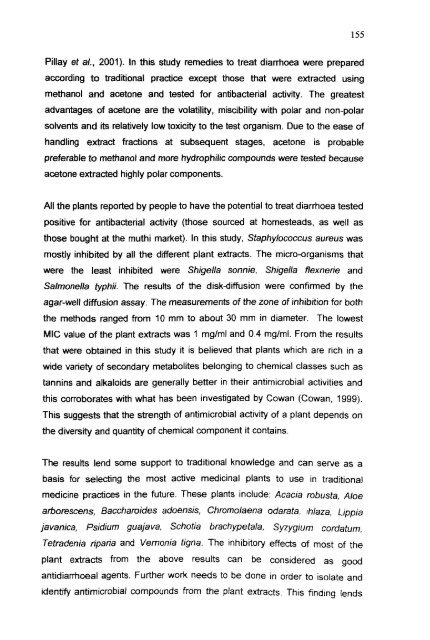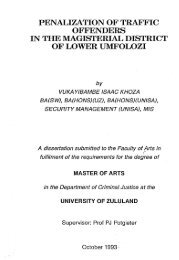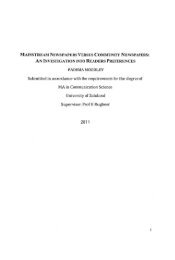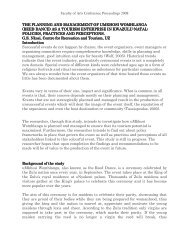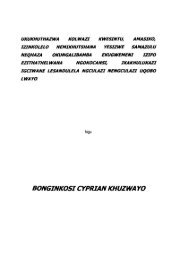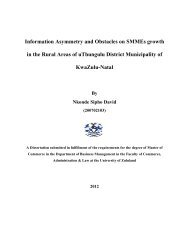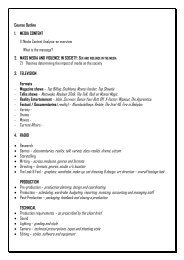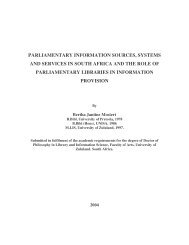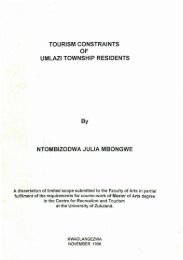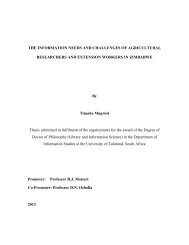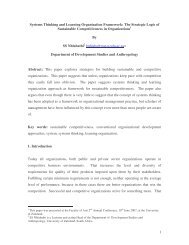The screening of medicinal plants traditionally used to treat ...
The screening of medicinal plants traditionally used to treat ...
The screening of medicinal plants traditionally used to treat ...
- No tags were found...
You also want an ePaper? Increase the reach of your titles
YUMPU automatically turns print PDFs into web optimized ePapers that Google loves.
155Pillay et al., 2001). In this study remedies <strong>to</strong> <strong>treat</strong> diarrhoea were preparedaccording <strong>to</strong> traditional practice except those that were extracted usingmethanol and ace<strong>to</strong>ne and tested for antibacterial activity. <strong>The</strong> greatestadvantages <strong>of</strong> ace<strong>to</strong>ne are the volatility, miscibility with polar and non-polarsolvents and its relatively low <strong>to</strong>xicity <strong>to</strong> the test organism. Due <strong>to</strong> the ease <strong>of</strong>handling extract fractions at subsequent stages, ace<strong>to</strong>ne is probablepreferable <strong>to</strong> methanol and more hydrophilic compounds were tested becauseace<strong>to</strong>ne extracted highly polar components.All the <strong>plants</strong> reported by people <strong>to</strong> have the potential <strong>to</strong> <strong>treat</strong> diarrhoea testedpositive for antibacterial activity (those sourced at homesteads, as well asthose bought at the muthi market). In this study, Staphylococcus aureus wasmostly inhibited by all the different plant extracts. <strong>The</strong> micro-organisms thatwere the least inhibited were Shigella sonnie, Shigella flexnerie andSalmonella typhii. <strong>The</strong> results <strong>of</strong> the disk-diffusion were confirmed by theagar-well diffusion assay. <strong>The</strong> measurements <strong>of</strong> the zone <strong>of</strong> inhibition for boththe methods ranged from 10 mm <strong>to</strong> about 30 mm in diameter. <strong>The</strong> lowestMIC value <strong>of</strong> the plant extracts was 1 mg/ml and 0.4 mg/ml. From the resultsthat were obtained in this study it is believed that <strong>plants</strong> which are rich in awide variety <strong>of</strong> secondary metabolites belonging <strong>to</strong> chemical classes such astannins and alkaloids are generally better in their antimicrobial activities andthis corroborates with what has been investigated by Cowan (Cowan, 1999).This suggests that the strength <strong>of</strong> antimicrobial activity <strong>of</strong> a plant depends onthe diversity and quantity <strong>of</strong> chemical component it contains.<strong>The</strong> results lend some support <strong>to</strong> traditional knowledge and can serve as abasis for selecting the most active <strong>medicinal</strong> <strong>plants</strong> <strong>to</strong> use in traditionalmedicine practices in the future. <strong>The</strong>se <strong>plants</strong> include: Acacia robusta, Aloearborescens, Baccharoides adoensis, Chromolaena odarata, fhlaza, Uppiajavanica, Psidium guajava, Schotia brachypeta/a, Syzygium cordatum,Tetradenia riparia and Vemonia tigna. <strong>The</strong> inhibi<strong>to</strong>ry effects <strong>of</strong> most <strong>of</strong> theplant extracts from the above results can be considered as goodantidiarrhoeal agents. Further work needs <strong>to</strong> be done in order <strong>to</strong> isolate andidentify antimicrobial compounds from the plant extracts. This finding lends


